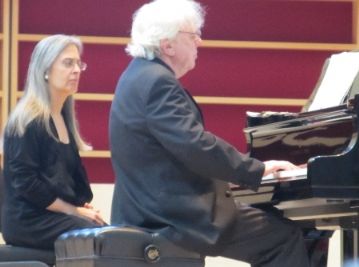|
Recital
ELEGANT VOCAL MASTERY AT ROSES SIGNATURE RECITAL
by Pamela Hicks Gailey
Sunday, February 25, 2024
Recital
DEMANDING SCHUMANN WORK IN MUSIC AT OAKMONT RECITAL
by Terry McNeill
Thursday, November 9, 2023
Recital
RARE RAVEL IN MENDO FESTIVAL'S PRESTON HALL
by Terry McNeill
Thursday, July 20, 2023
Recital
FRENCH FLAVOR IN RARE FOUR-HAND RECITAL
by Judy Walker
Sunday, January 15, 2023
Recital
ASSERTIVE PIANISM IN YAKUSHEV'S OCCIDENTAL RECITAL
by Terry McNeill
Sunday, November 13, 2022
Recital
HEROIC LIM PERFORMANCE AT STEINWAY SOCIETY RECITAL
by Abby Wasserman
Sunday, September 18, 2022
Recital
AGGRESSIVE PIANISM IN MYER'S MENDO FESTIVAL RECITAL
by Terry McNeill
Thursday, July 14, 2022
Recital
UNIQUE ELEGANCE IN GALBRAITH GUITAR RECITAL
by Gary Digman
Friday, April 29, 2022
Recital
ALLURING GLASS WORKS IN WEILL RECITAL
by Terry McNeill
Friday, March 25, 2022
Recital
FORGOTTEN BACH SHINES IN YARDEN'S OAKMONT RECITAL
by Terry McNeill
Thursday, March 10, 2022
|
 |
 Marcia Weinfeld and Richard Goode in Weill Hall May 18 |
ELEGANCE AND INTROSPECTION
by Nicki Bell
Sunday, May 18, 2014
A May 18 Weill Hall audience was led by the hands and heart of Richard Goode to a quiet realm of the sublime with a performance of the masterful last three Beethoven Piano Sonatas.
The program was billed as the first time the artist has toured with the Op. 109, 110 and 111 pieces, and these weighty works were leavened somewhat by lighter Beethoven, the eleven short Op. 119 Bagatelles, that opened the second half. Mr. Goode's playing has always avoided the colossal and histrionic in Beethoven, concentrating the musical experience in contrasts that underscore both power and delicacy. It’s an admirable approach removed from a French or Slavic style in Beethoven.
Beginning with the E Major Sonata, Op. 109, the pianist immediately established a strong rhythmic pulse which later carried over into the A Flat and C Minor Sonatas. The second movement of Op. 109 was played aggressively with a lengthy theme and six variations and a clearly-articulated fugue. The trills were technically secure and the reading built to the serene return of the lovely theme.
Opus 110 was similarly dramatic, even more so with insistent lyricism and the pianist deftly portraying the Arioso’s inward despair. The concluding fugue had subtle voice leadings that built gradually to a full and commanding ending.
Concluding the recital was a stormy performance of the Op. 111 work, especially potent in the “Maestos – Allegro con brio ed appassionato” movement. Here the artist scaled technical and interpretative heights with impressive speed and endurance. The monumental and ecstatic Arietta theme was a deeply moving experience and Mr. Goode maintained the basic tempo throughout the variations, including the fourth variation which is frequently played too fast. The performance of this autumnal work had a shimmering depth of emotion and sensitivity palpable to the audience sprinkled with pianists. Surprisingly there was not the usual Op. 111 "held breath" hush, and Mr. Goode appeared disconcerted at the all-too-soon ovation. There was no encore.
The 70-year old pianist played entirely from score, a somewhat rare occurrence given Mr. Goode’s eminence, and the artist selected Weill’s newest concert instrument that proved to have an overly bright treble.
Dean Morse and Sonia Tubridy contributed to this review
|

